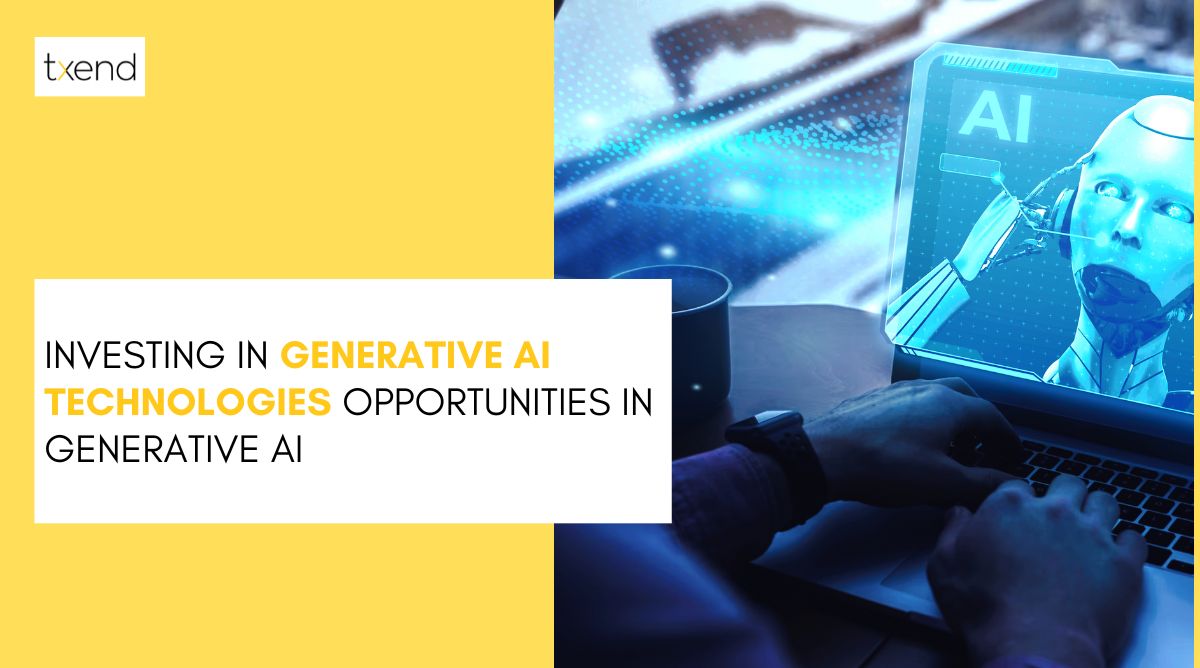
In the dynamic landscape of modern technology, one innovation stands out as a game-changer: Generative Artificial Intelligence. The convergence of machine learning and creativity, generative AI has sparked a revolution, redefining how we approach problem-solving, content creation, and innovation across various sectors.
As businesses and industries continue to adapt and thrive in the digital age, investing in generative AI technologies has emerged as a strategic imperative.
The allure of generative AI lies in its ability to empower machines with the capacity to think, create, and adapt autonomously. It’s a technology that can generate art, language, music, and even entire solutions to complex challenges.
From deep learning algorithms that craft imaginative works of art to natural language models capable of crafting human-like text, the potential applications of generative AI are vast and transformative.
This article takes you on a journey through the landscape of investing in generative AI, providing insights into the opportunities that abound in this groundbreaking field. We’ll explore how generative AI is not just a disruptive force, but a catalyst for innovation, reshaping entire industries and presenting an array of investment avenues for forward-thinking individuals and organizations.
Whether you’re an investor looking to navigate the generative AI landscape, a business leader seeking to harness its potential, or simply a curious mind intrigued by the future of artificial intelligence, this article aims to be your guiding light.
Together, let’s embark on a voyage to understand the disruptive power, identify the vast applications, and recognize the scalability of generative AI solutions. Welcome to the world of “Investing in Generative AI Technologies: Opportunities in Generative AI.” Let’s explore this uncharted territory and discover the limitless potential it holds.
Key Takeaways
- Generative AI has the capacity to disrupt industries by enabling machines to create and innovate.
- Generative AI can be applied in numerous sectors, including healthcare, finance, content creation, product design, and software development.
- Generative AI solutions are adaptable to various business sizes and industries, offering growth and innovation opportunities.
- Product design and manufacturing processes are being transformed by AI-generated designs and simulations.
- Collaborating with venture capital funds specializing in generative AI can provide access to emerging opportunities.
- It’s crucial to evaluate technology risks and limitations when considering generative AI investments.
Landscape of Investing Generative AI
When combined, “Landscape of Investing in Generative AI” suggests that your article explores and provides an overview of the opportunities, challenges, trends, and considerations within the realm of investing in generative AI technologies.
It may touch on topics such as market trends, emerging applications, potential risks, competitive dynamics, and the long-term outlook for investors in the generative AI space. This title sets the stage for a comprehensive exploration of the investment landscape in the field of generative AI.
Understanding the Disruptive Power of Generative AI:
In this section of the article, you would delve into the disruptive potential of generative AI technologies. You could discuss how generative AI is transforming various industries and explain the concepts and principles that underlie its disruptive power.
Highlight real-world examples and case studies that demonstrate how generative AI is reshaping businesses and markets.
Identifying the Vast Applications of Generative AI:
This section could focus on the diverse applications of generative AI. It’s an opportunity to explore how these technologies are being used in different sectors such as healthcare, finance, art, and more.
Discuss the practical use cases, benefits, and outcomes that generative AI solutions can provide in these domains.
Recognizing the Scalability of Generative AI Solutions:
Here, you would address the scalability and growth potential of generative AI solutions. Explain how these technologies can be deployed in various contexts, whether in small startups or large enterprises. Discuss the adaptability of generative AI for different business sizes and industries, emphasizing its capacity for expansion and innovation.
Overall, the article appears to be a comprehensive guide for investors interested in generative AI technologies. It outlines the landscape of investing in generative AI, provides insights into the disruptive power of these technologies, showcases their wide-ranging applications, and highlights their scalability, making it a useful tool for people wishing to decide on investments in this industry with knowledge.
Unveiling the Opportunities in Generative AI
Revolutionizing Drug Discovery and Healthcare:
This section of the article can delve into how generative AI is transforming the healthcare and pharmaceutical industries. It can go over how treatment plans, patient care, and drug discovery are all improved by using AI-powered tools and algorithms.
Transforming Financial Modeling and Investment Strategies:
In this part, you can explore how generative AI is being applied in the financial sector. Discuss its impact on financial modeling, algorithmic trading, risk assessment, and investment strategies. Highlight how generative AI can provide data-driven insights for better decision-making in finance.
Redefining Content Creation and Marketing:
This section can focus on the creative applications of generative AI. It can discuss how AI is changing content creation, such as generating written content, images, videos, and advertisements. Also, explore how it’s enhancing marketing efforts, personalization, and customer engagement.
Reshaping Product Design and Manufacturing:
Discuss how generative AI is impacting product design and manufacturing processes. Explore how AI-generated designs and simulations are optimizing the product development cycle, reducing costs, and enhancing product quality.
Automating Software Development and Programming:
This part can cover how generative AI is used in software development. Explain how AI tools can automate coding tasks, assist developers, and improve software quality and efficiency.
By covering these subtopics, your article will offer a comprehensive view of the opportunities that generative AI presents across various industries and sectors.
It provides readers with a well-rounded understanding of how generative AI is transforming these domains and how investments in this technology can lead to significant advancements and returns.
Approaching Generative AI Investments with Confidence
Investing in Publicly Traded Generative AI Companies:
This section of the article can delve into the specifics of investing in established generative AI companies that are publicly traded.
It should offer guidance on how to research, analyze, and make informed investment decisions in such companies, taking into account factors like financial performance, market trends, and growth potential.
Partnering with Venture Capital Funds Focused on Generative AI:
Discuss the advantages and considerations of partnering with venture capital funds that specialize in generative AI. This section can explore how these funds operate, their investment strategies, and how individual investors or entities can collaborate with them to access generative AI opportunities.
Directly Investing in Promising Generative AI Startups:
In this part, you can explain the process of directly investing in early-stage generative AI startups. Offer insights on how to identify promising startups, conduct due diligence, and make strategic investments. Discuss the advantages and disadvantages of funding startups as well as strategies for assisting their growth.
By covering these subtopics, your article will provide readers with a comprehensive understanding of different approaches to investing in generative AI. It will offer guidance on confidently navigating the generative AI investment landscape, whether through publicly traded companies, venture capital funds, or direct investments in startups.
This holistic perspective can equip readers with the knowledge and confidence to make informed and strategic investment decisions in the field of generative AI.
Risk Management and Reward Strategies in Generative AI
Assessing Technology Risks and Potential Limitations:
In this section, you can delve into the technical risks and limitations associated with generative AI technologies. Discuss issues such as data quality, algorithm biases, and the current state of AI technology. Offer insights into how to assess these risks and mitigate potential limitations in generative AI applications.
Understanding Market Uncertainty and Growth Potential:
Explore the market-related uncertainties that investors may face when considering generative AI investments. Discuss factors like market trends, competition, and the potential for rapid technology advancements. Provide strategies for understanding and navigating the market dynamics to make informed investment decisions.
Navigating Regulatory Landscape and Ethical Considerations:
This section can focus on the regulatory and ethical challenges tied to generative AI. Discuss issues such as data privacy, intellectual property, and the ethical use of AI in various applications. Provide guidance on navigating the intricate regulatory environment and integrating moral issues into investment plans.
By covering these subtopics, your article will provide a well-rounded view of the risks and rewards in generative AI investments.
It will offer readers valuable guidance on how to assess and manage technology risks, understand market dynamics, and navigate regulatory and ethical considerations to make informed and responsible investment decisions in the field of generative AI.
Frequently Asked Questions
In artificial intelligence, generative AI is a subset that focuses on producing information, solutions, or content on its own. Examples of these include producing text, graphics, music, or even computer code.
Investing in generative AI is attractive because it offers the potential for innovation, automation, and competitive advantages across various industries.
Some risks associated with investing in generative AI include algorithm biases, data privacy concerns, and uncertainty in market adoption.
Diversify your investments, stay updated on emerging trends, and conduct thorough due diligence on AI companies.
Conclusion
In this exploration of the distinctions between AI and Generative AI, we’ve unveiled a fascinating landscape where innovation and creativity intersect with structured problem-solving. “What is the difference between Generative AI and AI?” is a question that has been aptly addressed.
AI, with its rule-based and structured approach, has revolutionized industries by solving specific, well-defined tasks efficiently. On the other hand, Generative AI stands as the vanguard of creative innovation, generating new content and adapting to a multitude of tasks.
From image and text generation to music composition and video synthesis, Generative AI showcases its potential in diverse domains. It’s not just a tool; it’s a wellspring of creativity and adaptability.
In the dynamic corporate landscape, understanding these distinctions is pivotal. Leaders of multinational corporations must be equipped with this knowledge to harness the transformative power of both AI and Generative AI effectively.
Whether it’s enhancing operational efficiency or pushing the boundaries of creative expression, these technologies hold the key to staying competitive and innovative in an ever-evolving global market.
“What is the difference between Generative AI and AI?” The answer lies in the duality of structured problem-solving and creative ingenuity, both of which are integral to the future of technology and business.
